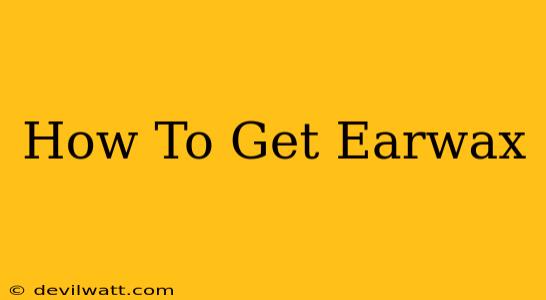Earwax, or cerumen, is a naturally occurring substance produced by glands in your ear canal. While it serves a protective function, excessive buildup can lead to discomfort, hearing loss, and even infection. This guide will explain how to safely and effectively manage earwax buildup, focusing on prevention and professional removal when necessary. Never attempt to remove excessive earwax at home without proper guidance.
Understanding Earwax Buildup
Before we delve into removal methods, it's crucial to understand why earwax buildup occurs. Most people's ears naturally clean themselves through jaw movement and skin migration. However, certain factors can contribute to excessive wax accumulation:
- Using cotton swabs: Ironically, using cotton swabs often pushes wax further into the ear canal, compacting it and causing blockages.
- Hearing aids: These devices can trap earwax and accelerate buildup.
- Narrow ear canals: Individuals with naturally narrow ear canals are more prone to impaction.
- Excessive hair in the ear canal: This can trap wax and debris.
- Certain medications: Some medications can lead to drier earwax, which is more likely to build up.
How to Prevent Earwax Buildup
The best approach to earwax is prevention. Here's how:
- Avoid cotton swabs: Resist the urge to use cotton swabs to clean your ears.
- Gentle ear cleaning: You can gently wipe the outer ear with a soft, damp cloth.
- Regular ear hygiene: Consult your doctor about ear irrigation or other professional cleaning methods if you are prone to blockage.
- Proper use of hearing aids: Clean your hearing aids regularly according to manufacturer instructions.
When to See a Doctor About Earwax
While some earwax is normal, you should consult a doctor if you experience any of the following:
- Hearing loss: A significant blockage can muffle sounds.
- Ear pain: Pain, especially accompanied by discharge, could signify an infection.
- Ear itching: Excessive itching may indicate irritation from the buildup.
- Ringing in the ears (tinnitus): This can sometimes be associated with earwax impaction.
- Feeling of fullness in the ear: This is a common symptom of a wax blockage.
Professional Earwax Removal Methods
Your doctor or an audiologist can perform several safe and effective earwax removal methods, including:
- Ear irrigation: This involves using a gentle stream of water to flush out the wax.
- Manual removal: Using specialized instruments, a doctor can carefully remove the wax.
- Suction: A suction device can efficiently remove compacted wax.
Important Note: Never attempt to use home remedies like candles or hydrogen peroxide to remove earwax without professional guidance. These methods can be extremely dangerous and potentially damage your eardrum.
Conclusion
Maintaining good ear hygiene is essential for overall ear health. Preventing excessive wax buildup through gentle cleaning and avoiding cotton swabs is key. However, when you experience symptoms of wax impaction, always seek professional help from a doctor or audiologist for safe and effective removal. They have the expertise and tools to clear blockages without risking damage to your delicate ear structures.

